Written by: Deep Tide TechFlow
The crypto market is gradually warming up, with BTC and ETH leading the charge. However, the main coin prices of many L1 public chains have failed to achieve a corresponding rebound, and the current scenario is far from the earlier competition among hundreds of chains to dethrone Ethereum.
Currently, L1s are facing the challenge of 'main coin marginalization': circulation unlocks, token dilution, and weak narratives make it difficult for these main coins to capture the value of ecological growth.
As an innovative EVM-compatible public chain, Berachain occupies a place in the public chain ecology with its unique Proof of Liquidity (PoL) mechanism, but the three-token model also results in insufficient value capture capability for its main coin BERA, which currently has a market capitalization of only $270 million.
$BERA's current situation is not only due to traditional token economics issues (such as unlock pressure) but also the lack of narrative and product application.
If $BERA is merely a tool for paying gas on the chain, its narrative imagination space would naturally be much smaller. However, a recent PoL V2 proposal in the official Berachain community may provide an opportunity for $BERA to reverse its narrative and functional positioning.
By redistributing 33% of the PoL incentives, the aim is to transform $BERA from a marginalized gas token into a core revenue asset.

After the proposal was released on July 15, the price of $BERA skyrocketed by 23% within 24 hours, breaking the $2.5 mark, and the market interpreted it as a favorable signal and responded accordingly.
Beyond short-term effects, can PoL V2 bring long-term value to $BERA? Can it reshape the status of the main coin through incentive mechanisms and attract institutional and user participation?
The secret dilemma of the value of $BERA in the original PoL
To answer the above question, one needs to understand the current predicament of the main coin $BERA under Berachain's PoL model.
The original Proof of Liquidity (PoL V1) mechanism of Berachain is essentially a consensus design at the economic level, enhancing network security and ecological prosperity by incentivizing liquidity providers (LPs) and dApp development.
Unlike traditional PoS, PoL utilizes a three-token model ($BERA, $BGT, $HONEY) to distribute block rewards to validators and ecological participants through bribery auctions.
Among them, $BERA serves as a gas token and the fundamental asset of the network, $BGT is responsible for governance and staking rewards, while $HONEY supports liquidity as a stablecoin.
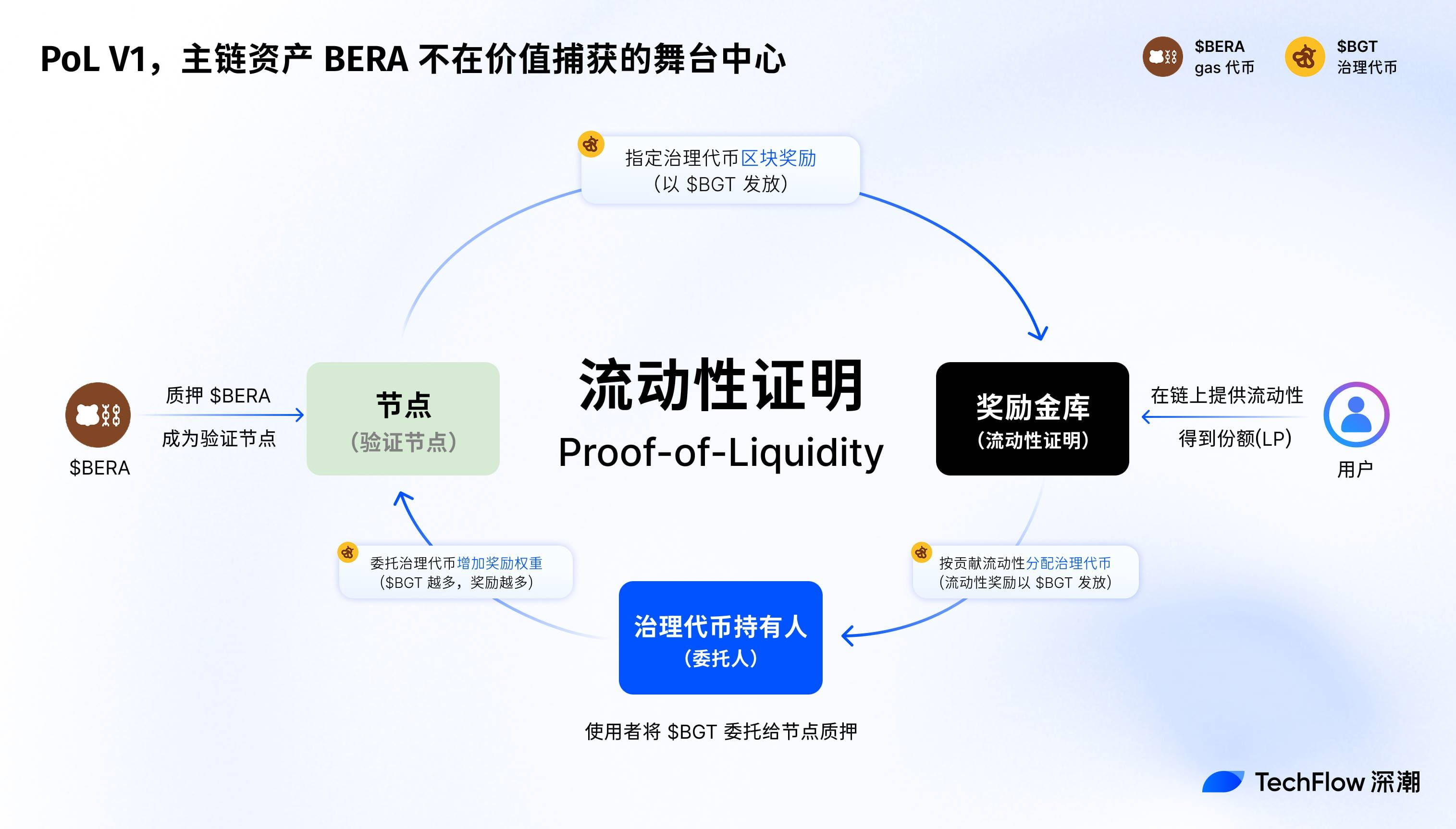
Since the mainnet went live on February 6, 2025, PoL has once driven the growth of Berachain's TVL, which reached a peak of $3 billion at the end of March this year.
In comparison, the market capitalization of the main coin BERA during the same period was only $900 million, with an MC/TVL ratio of less than one-third. $BERA does not seem to have gained better market performance from the ecological attractiveness of Berachain.
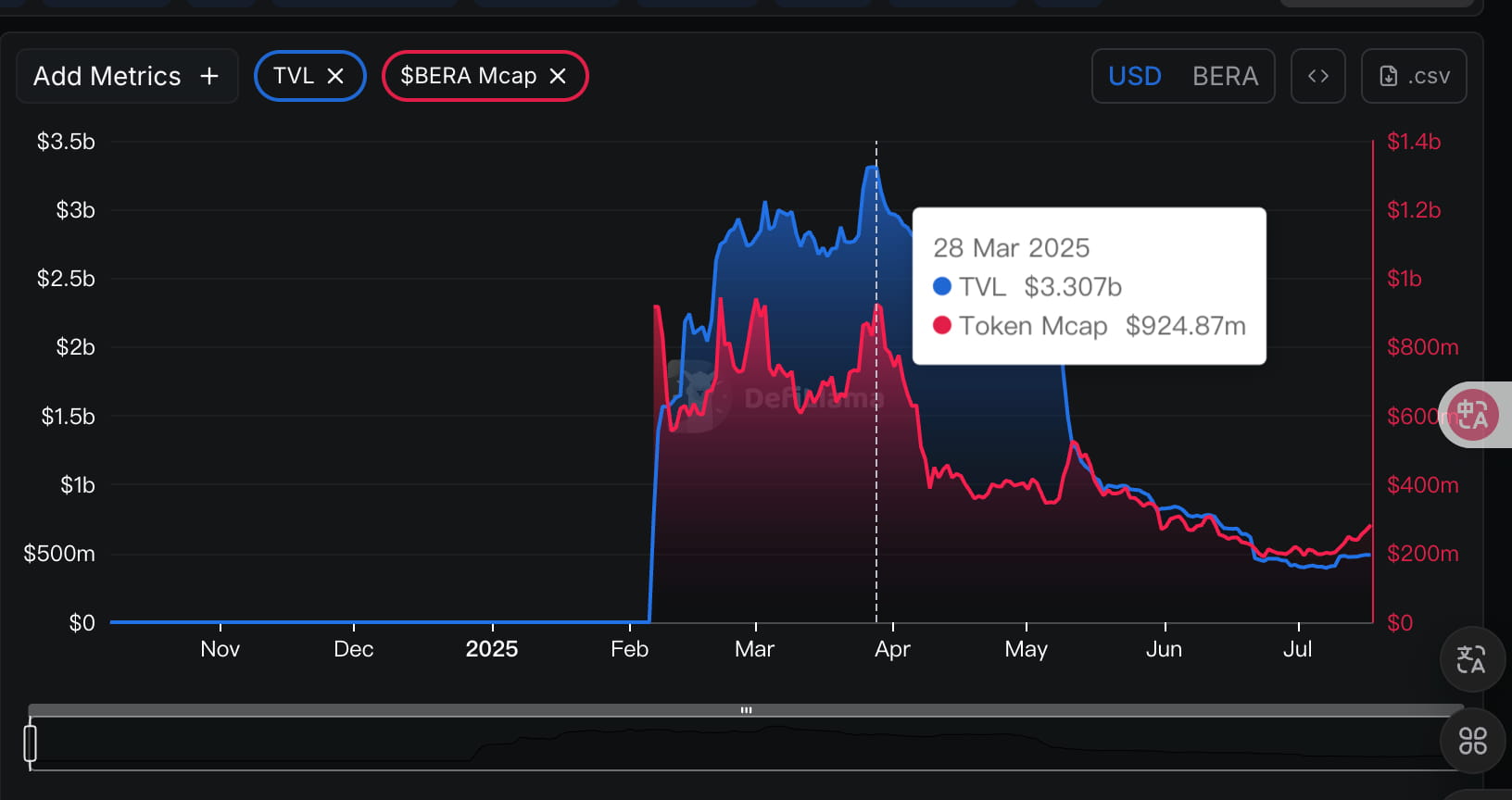
Where is the problem?
Looking back at the original design of PoL, I believe it was an arrangement that obeyed the overall interest, where incentive distribution and mechanism limitations led to the dilution of BERA's value.
The original PoL, in order to secure more ecological activity, cleverly designed a bribery and emission mechanism structurally, serving the overall development of Berachain. However, as the main chain asset, $BERA did not receive an equal opportunity for development, reflected in:
LPs capture the full staking rewards through the PoL bribery mechanism and distribute them using $BGT, while $BERA is only used for gas payments and lacks an independent source of income.
Bribery incentives are prioritized for $BGT holders, ignoring the needs of $BERA stakers, which indirectly reduces the market demand for $BERA.
The reward vault mechanism of PoL V1 concentrates liquidity incentives on dApps rather than the mainnet asset $BERA.
Overall, while Berachain can thrive, the ecosystem can thrive, and meme-based creative content can thrive, $BERA has not thrived. The rise of the main coin has become a pressing priority for enhancing the influence of public chains in the next phase.
The V2 proposal makes $BERA a core asset of the ecosystem.
Having understood the limitations of the original PoL on the value capture of BERA, let's take a look at the changes brought about by the PoL V2 proposal.
To conclude, PoL V2 focuses more on incentive redistribution and functional expansion, attempting to transform $BERA from a marginalized gas token into a core ecological asset.
Specifically, PoL V2 introduces the following key changes:
Incentive Redistribution:
PoL V2 redistributes 33% of DApp bribery incentives from $BGT (governance token) holders to BERA stakers.
According to furthermore data, Berachain has had approximately $500,000 in total incentives daily over the past week, which means that one-third of this amount ($150,000) will directly inject into the BERA staking pool, creating continuous buying pressure on BERA to a certain extent.
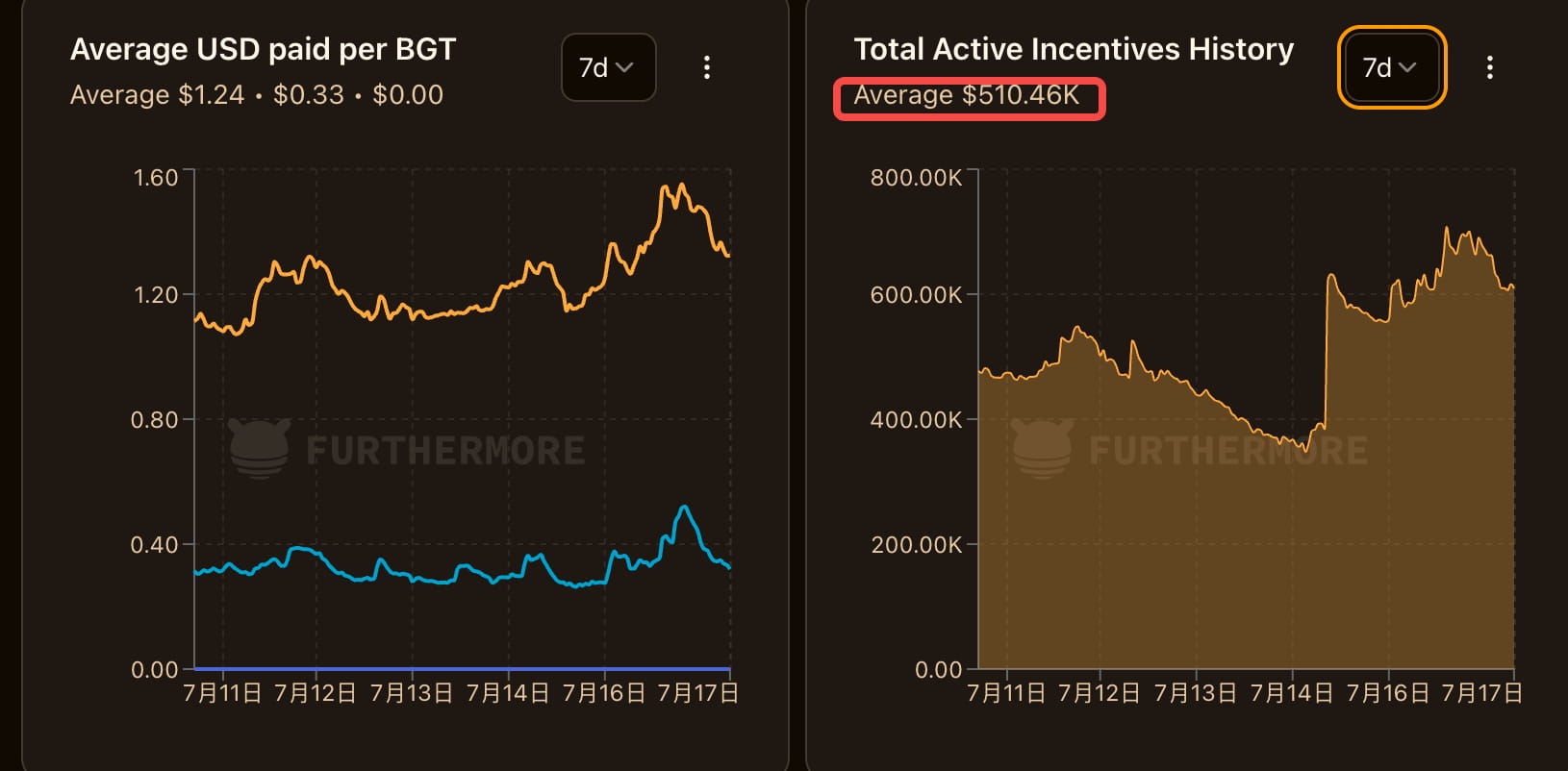
The remaining 67% of incentives continue to be distributed to $BGT holders, maintaining its liquidity incentive leverage effect and ensuring that the rights of existing stakeholders are not harmed.
Note that this effectively provides additional income to BERA holders, and the method of provision is not simply through additional issuance of BERA, but rather by reallocating cash flows within the protocol through structural adjustments, avoiding the risk of BERA inflation.
Function module expansion:
PoL V2 supports liquid staking tokens (LST), allowing BERA stakers to earn validator rewards while withdrawing their staking tokens to further earn PoL incentive income. This significantly improves the capital efficiency of BERA.
BERA stakers do not need to engage in complex DeFi strategies or hold BGT to directly profit from the revenues of on-chain protocols (like BEX), lowering the participation threshold.
We can also use a table to clearly compare the differences between V2 and V1 versions of PoL:
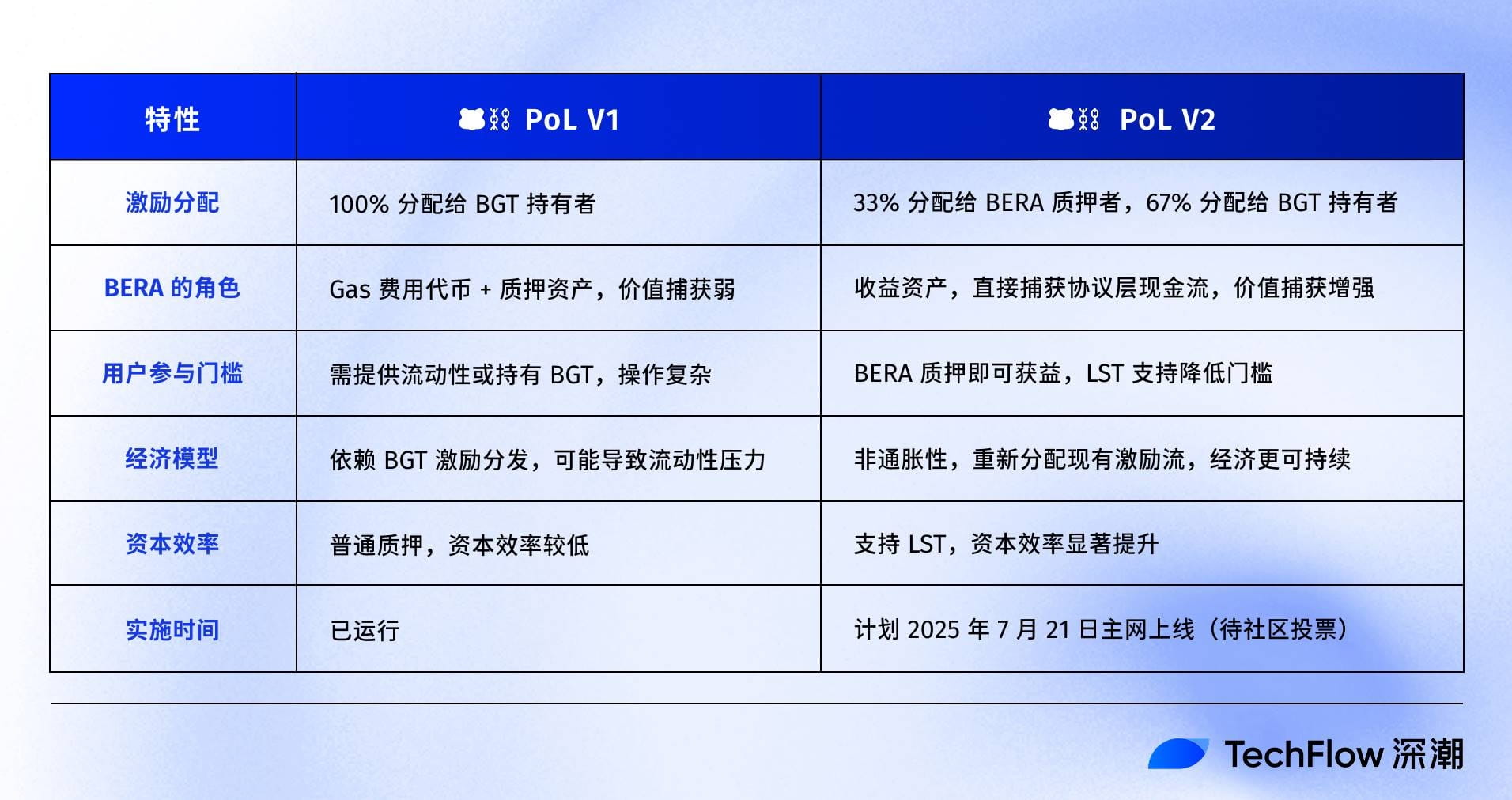
In contrast, PoL V1 is more like a stage tailor-made for $BGT, with most rewards flowing to it, while $BERA can only silently pay gas fees, with value growth relying entirely on indirect ecological stimulation.
V2 places $BERA at the center stage, simplifying the process of obtaining rewards through new reward distribution and bond tools.
Value capture, still value capture
Value capture is a high-frequency term in the crypto industry, but for BERA, where exactly does it anchor?
As BERA transforms from a single gas token to a core income-generating asset within the ecosystem, the anchoring of value will undergo subtle changes. This change lies in mental positioning and the ecology.
The core upgrade of PoL V2 lies in granting BERA the ability to directly capture cash flows at the protocol layer, akin to granting BERA protocol dividend rights, thereby reshaping its price logic.
We can do a theoretical calculation.
Assuming the V2 proposal is approved, by allocating 33% of DApp bribery incentives to BERA stakers, the previously mentioned data indicates that there are approximately $500,000 in total incentives daily. This implies that one-third of this amount ($150,000 daily, approximately $1.1 million weekly) becomes the income from staking BERA.
PoL V2 grants BERA a revenue stream similar to 'protocol dividends', meaning that holding BERA equates to sharing the real income generated within the entire ecology; under the positioning of income-generating assets, this will create buying pressure. Clearly, the price of BERA is also affected by token unlocks, and the actual multiplier may vary due to TVL growth, adoption rates, or market cycles. However, if the native token possesses more productive functions beyond merely paying gas, the current performance of BERA indicates that there is clearly more room for growth.
In comparison, if other public chains are placed together, the current MC/TVL ratio of BERA appears more promising.
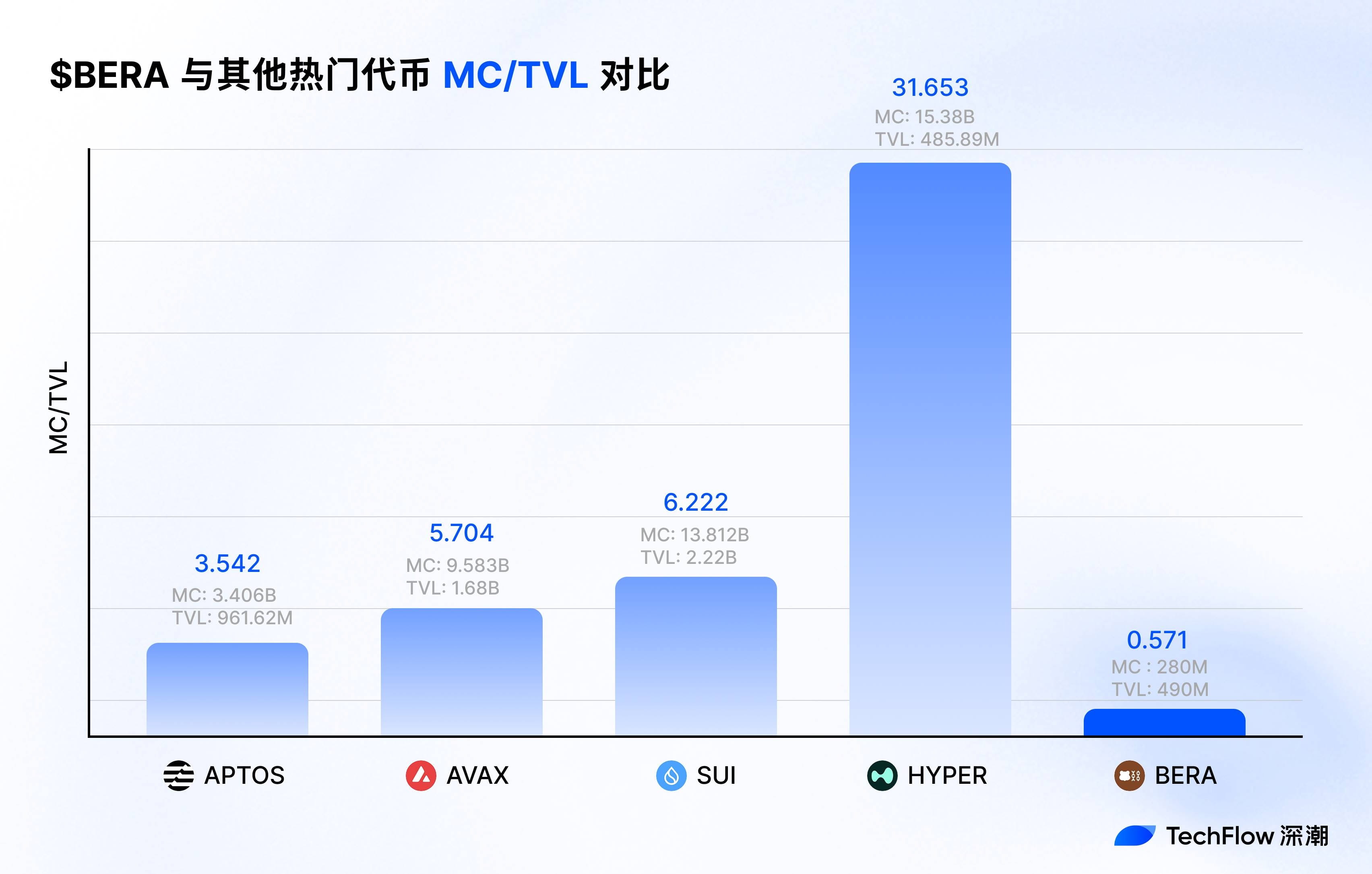
Furthermore, the positioning of BERA as an income-generating asset may trigger broader market imagination.
From the outside, companies like MicroStrategy have shown strategic interest in holding crypto assets by reserving Bitcoin. Companies like SharpLink have begun to reserve Ethereum, primarily because ETH is a 'productive asset'.
If PoL V2 grants BERA a stable revenue stream and non-inflationary design, making it an income-generating asset, it also provides a suitable environment for the current 'coin-stock play'.
From within the Berachain ecosystem, PoL V2 has spawned a positive flywheel mechanism.
First, the income of BERA stakers attracts more long-term holders, increases the token lock-up amount, and reduces market selling pressure.
Secondly, the stable price of BERA and higher network security attract more developers to deploy dApps, further increasing the sources of bribery incentives. In turn, more incentives flow to BERA and BGT holders, forming a closed loop of 'staking-incentives-dApp growth'.
For example, the trading volume of BEX (the core DEX of Berachain) may increase due to incentive optimization, thereby boosting the usage of HONEY (the native stablecoin) and strengthening the overall ecological stickiness.
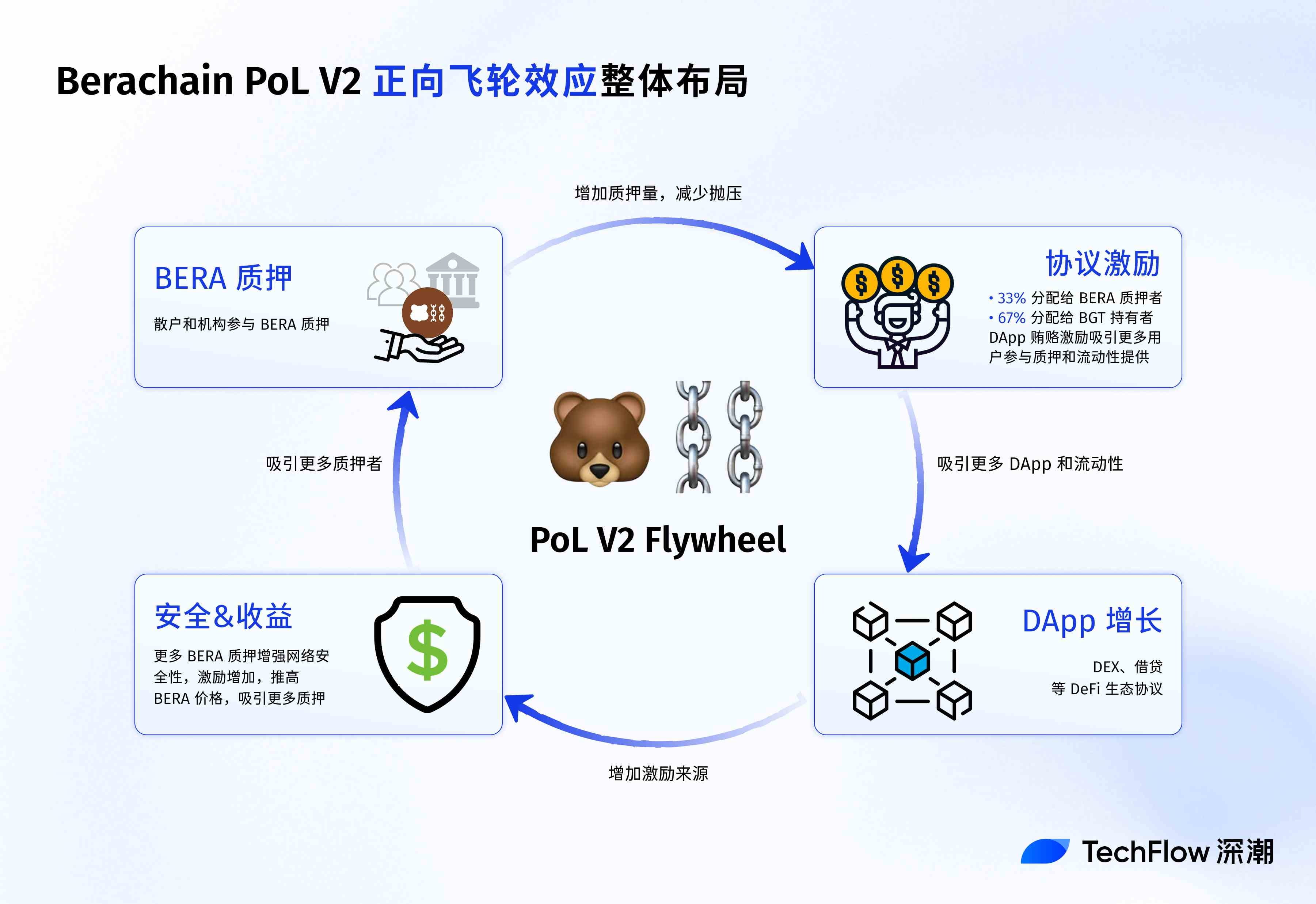
Compared to other Layer 1s that rely on token issuance to incentivize users, Berachain's model is closer to 'protocol dividends', providing long-term stability for the ecosystem.
From the user perspective, the value capture impact of PoL V2 focuses on different groups.
For retail investors, staking BERA provides a low-risk income path similar to 'crypto savings', attracting more long-term holders. For DeFi players, the introduction of LST means higher capital efficiency and strategic flexibility, such as using LST to provide liquidity in BEX while stacking PoL incentives.
For institutional users, the income-generating properties and non-inflationary design of BERA make it a potential strategic reserve asset, similar to stablecoins or high-yield bonds.
The current PoL V2 proposal was released on July 15, 2025, in the Berachain public forum and is currently in the community feedback stage, with a deadline of July 20, 2025.
If the proposal passes a majority vote, the mainnet will launch this proposal on July 21, 2025, at which point the changes in the value capture of BERA will be reflected.
However, it should be noted that the development of any public chain and the appreciation of its tokens cannot be solved solely by one proposal; the crypto market has reached a point where pure conceptual speculation has been debunked, and only projects with practical applications, income, and solid fundamentals can stand out in the battle of the second half.
As a supplement to the PoL V2 mechanism, as the ecology becomes more active, the revenue around BERA will rise. More protocols bidding for BGT means higher bribery amounts, which translates to better staking rewards for BERA.
Next, we can expect to see more native DeFi protocols for Bera coming online, such as the native lending protocol Bend, which will launch in 4 weeks; Berp, as a contract DEX, has confirmed its launch and is currently under development; Honey will expand to include more stablecoins as collateral, which will also go live in 3 weeks, making its role as a stablecoin more significant than before.
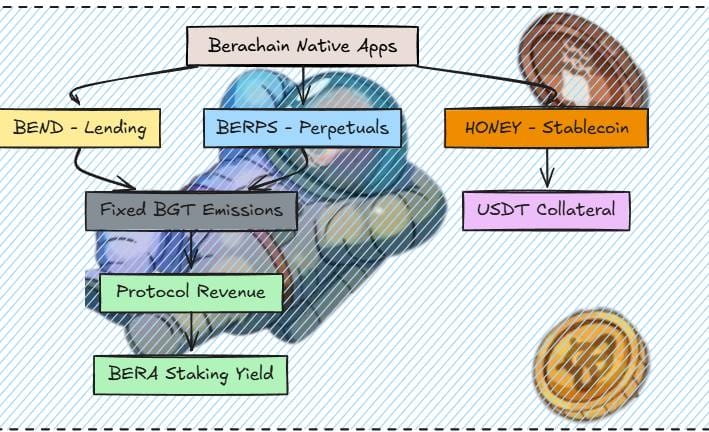
(Image source: @0xRavenium)
Additionally, the new Berahub page has recently gone live, upgrading the UI design, with a new asset pool page and one-click vault operation. This facilitates users in exploring the Berachain ecosystem's explore page and participating in various PoL income opportunities, rather than being limited to providing liquidity.
Perhaps projects are gradually realizing that public chains must first make themselves valuable before making the ecosystem valuable.
Using 'income-driven main coin', Berachain's new proposal has made a good start.




